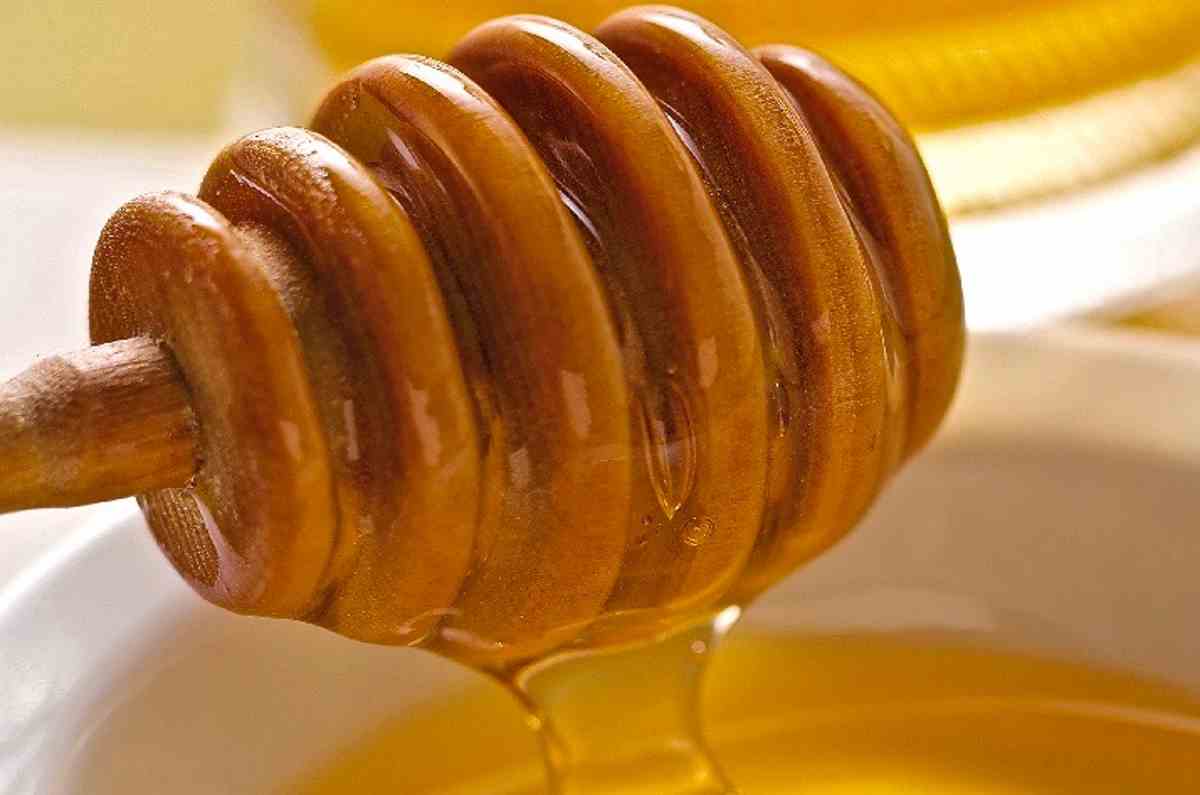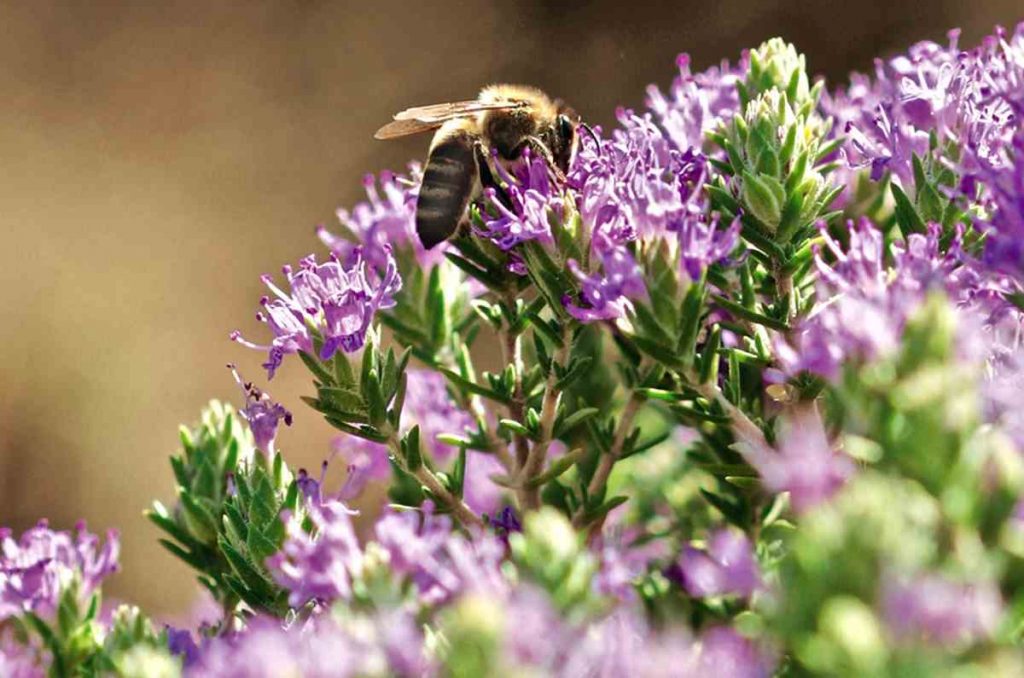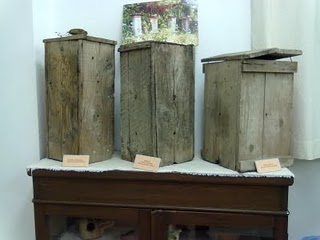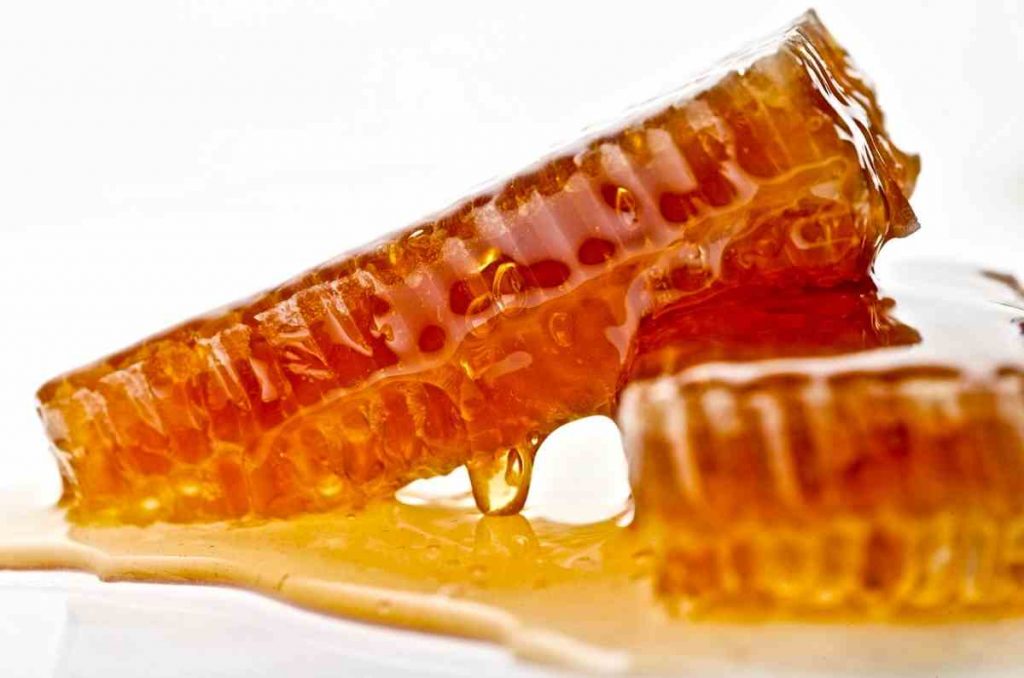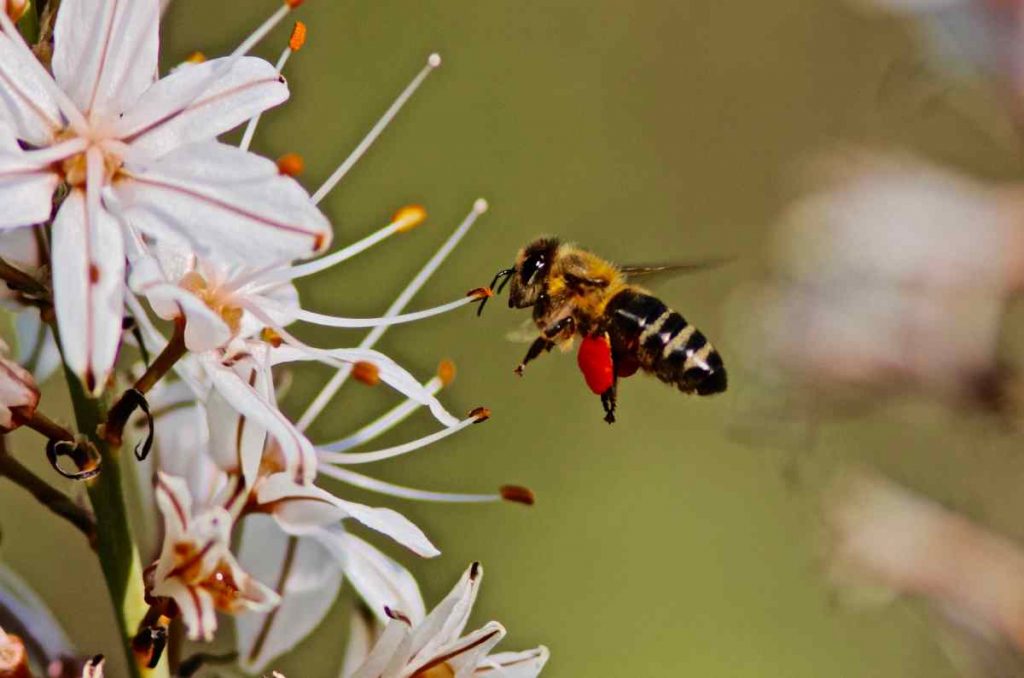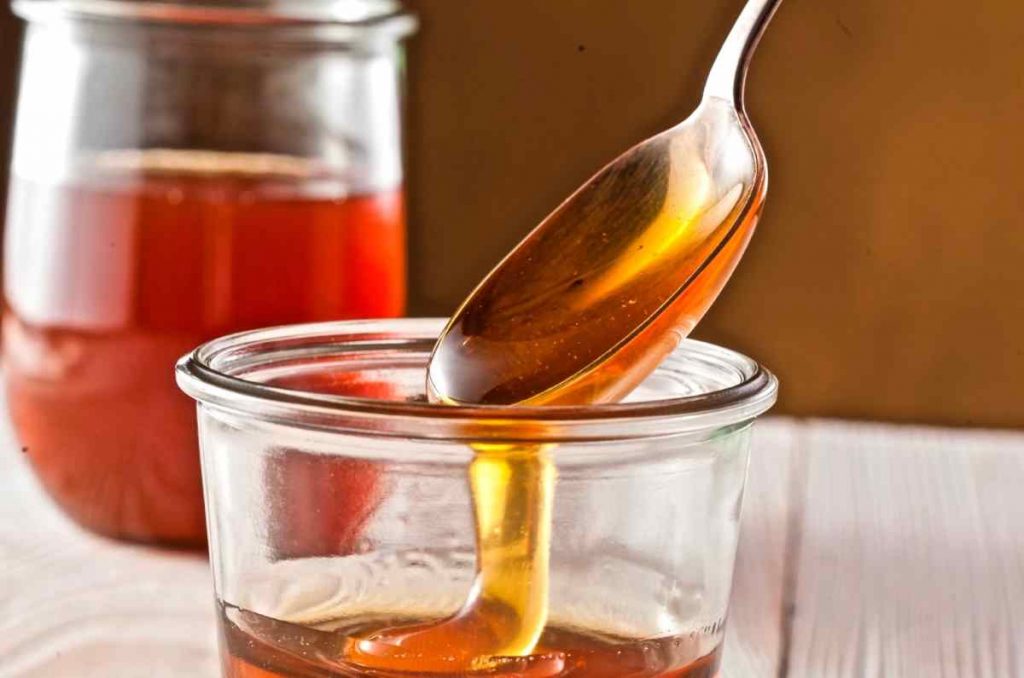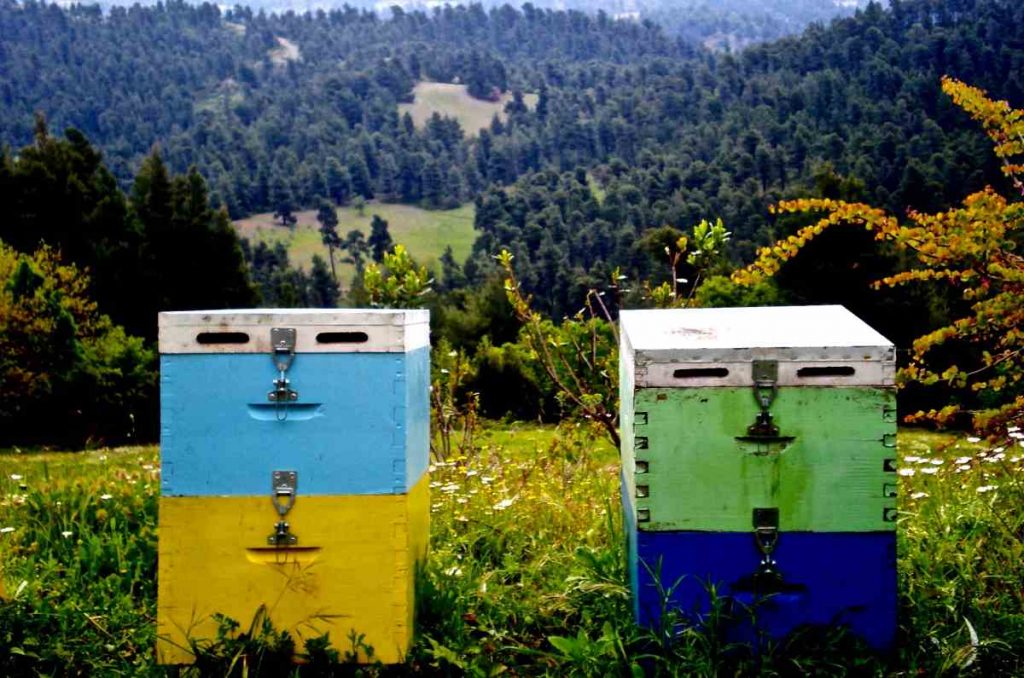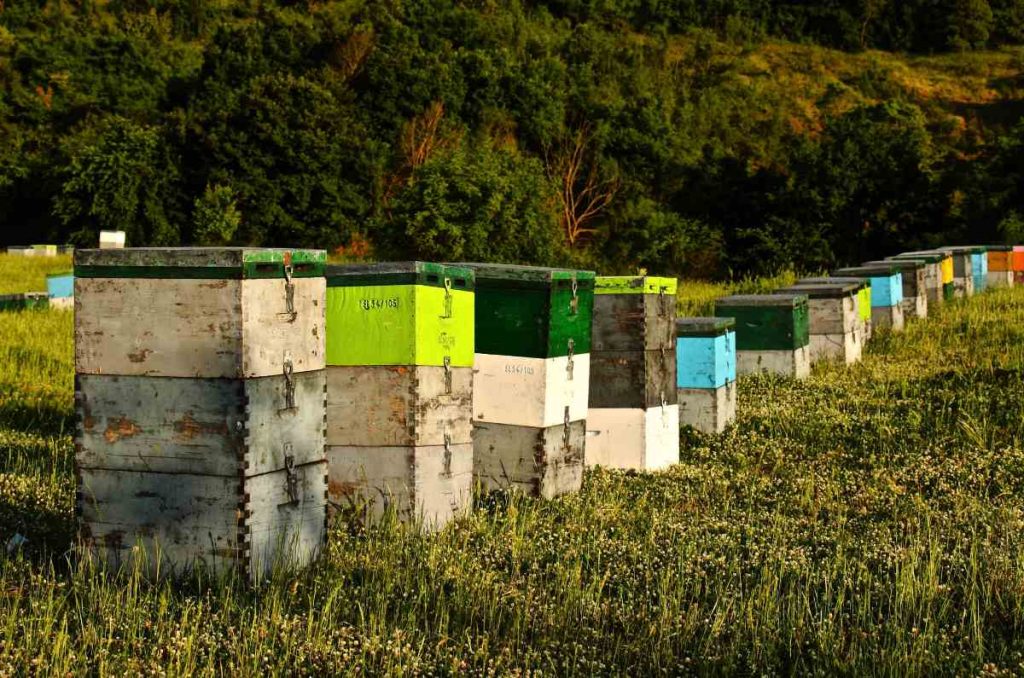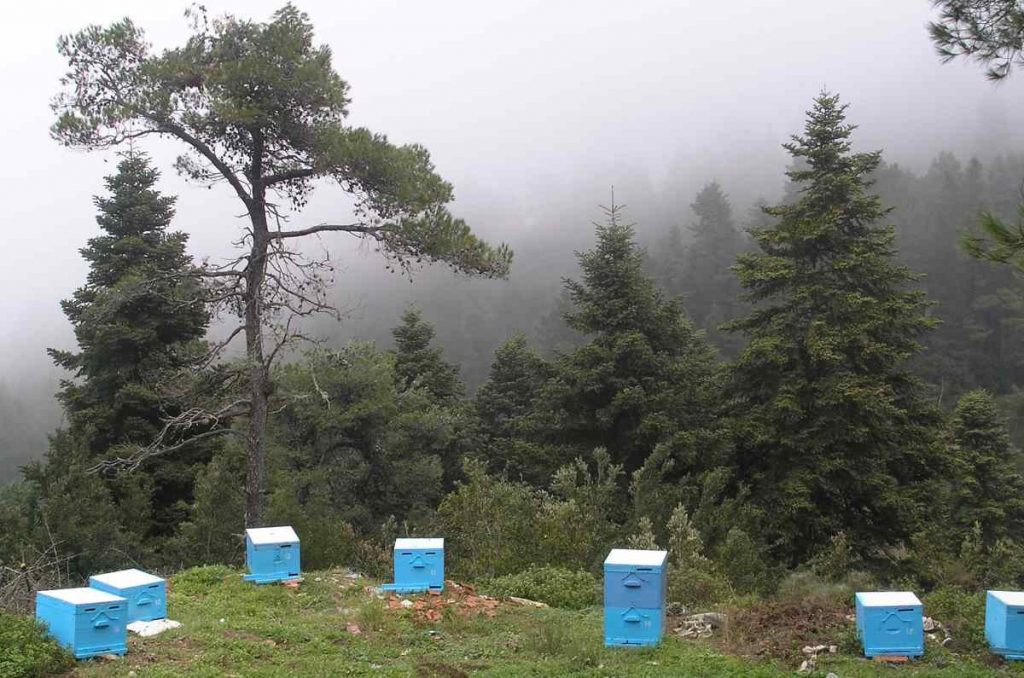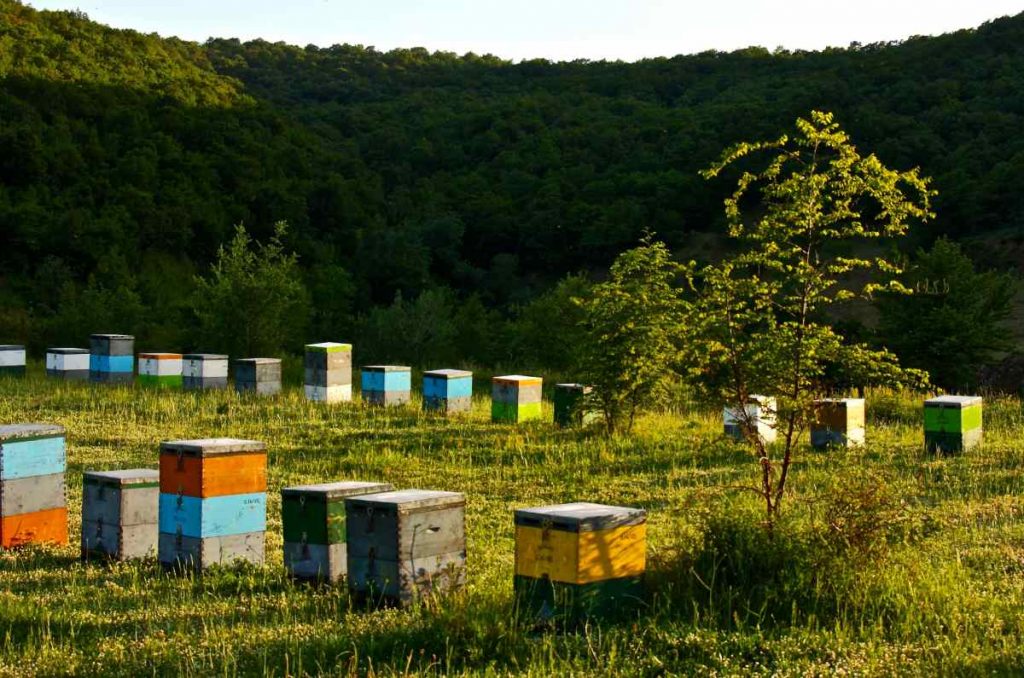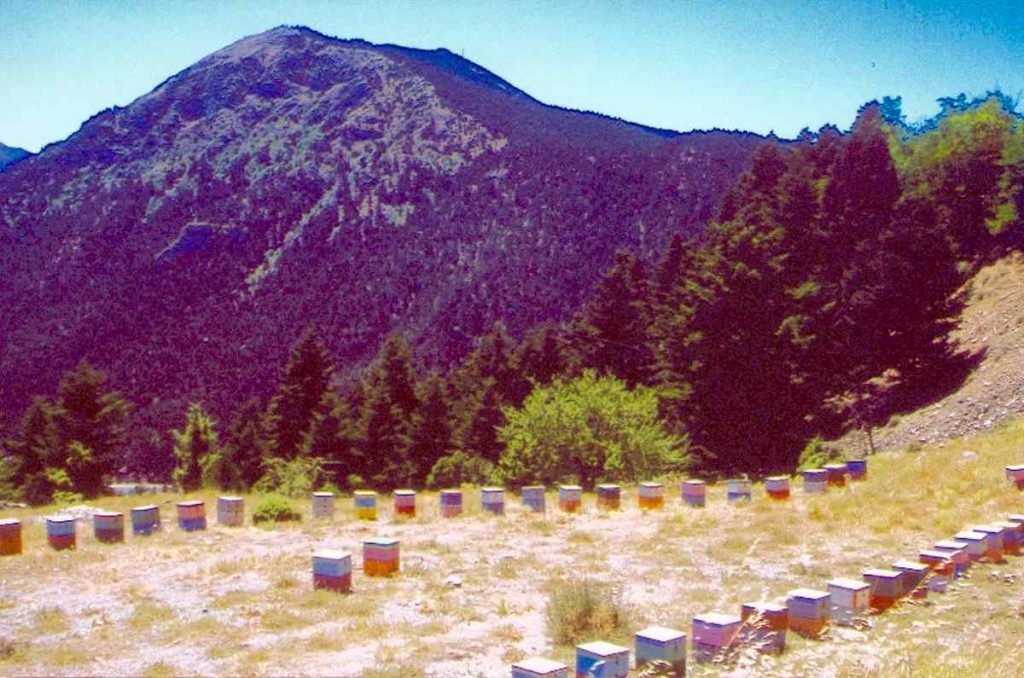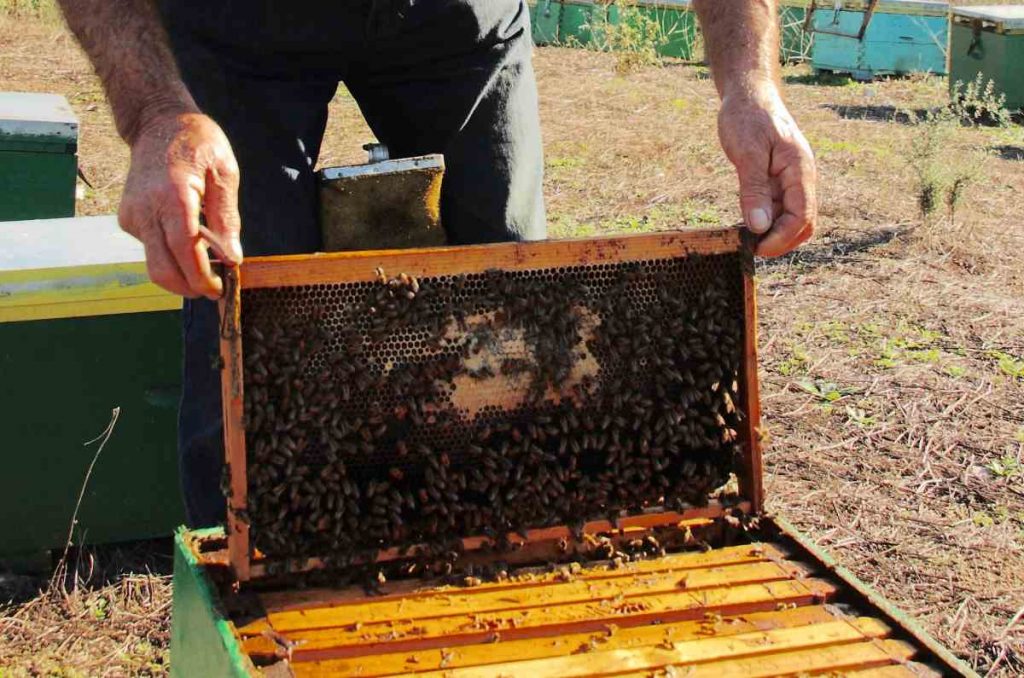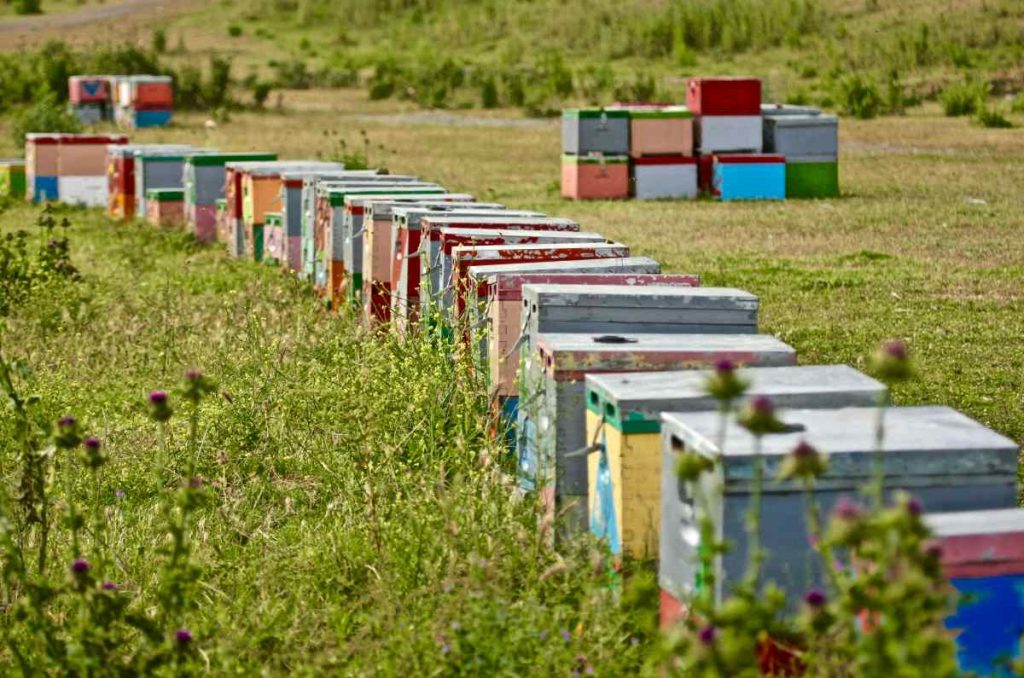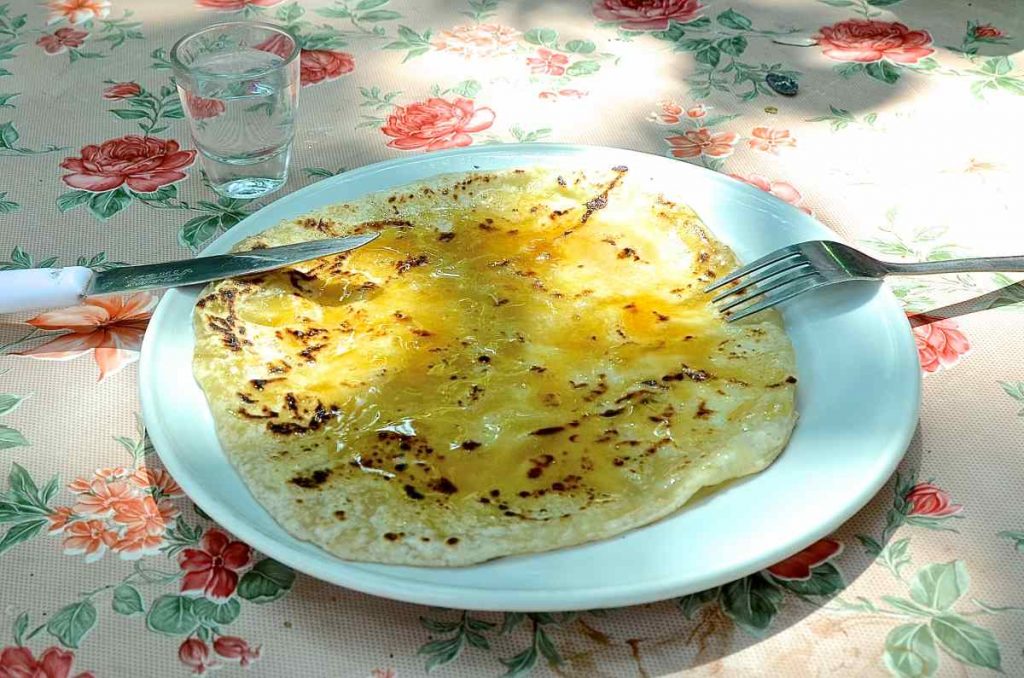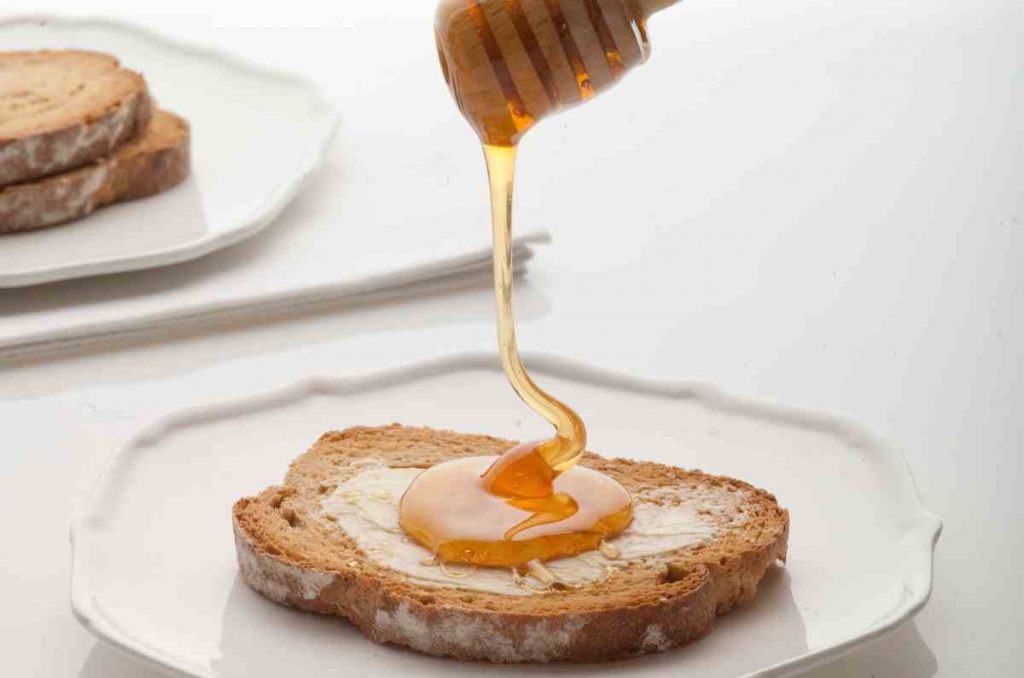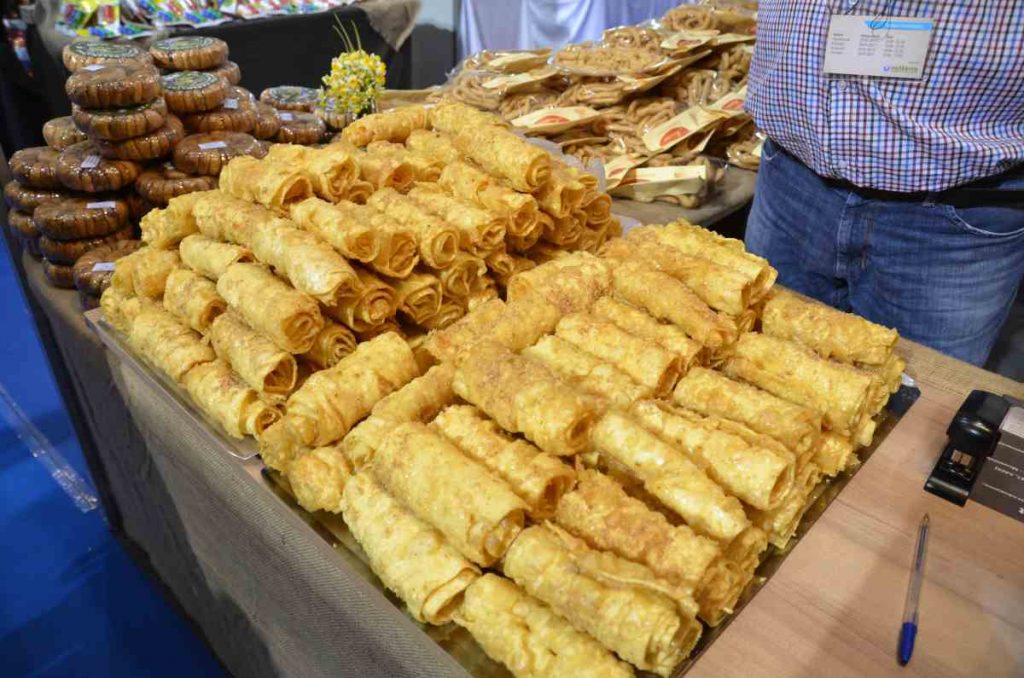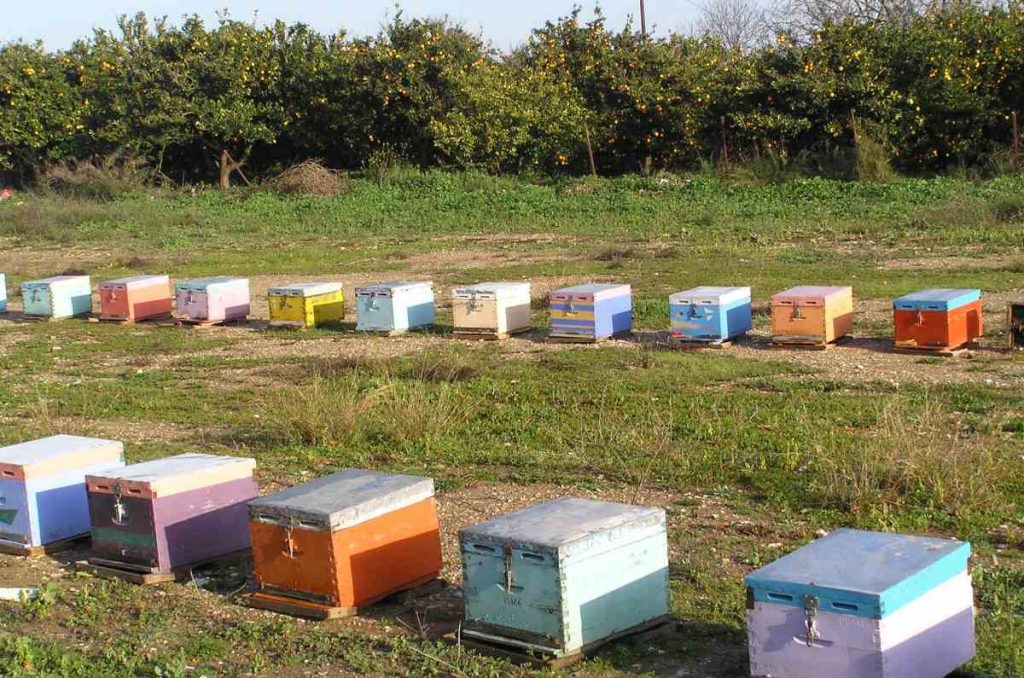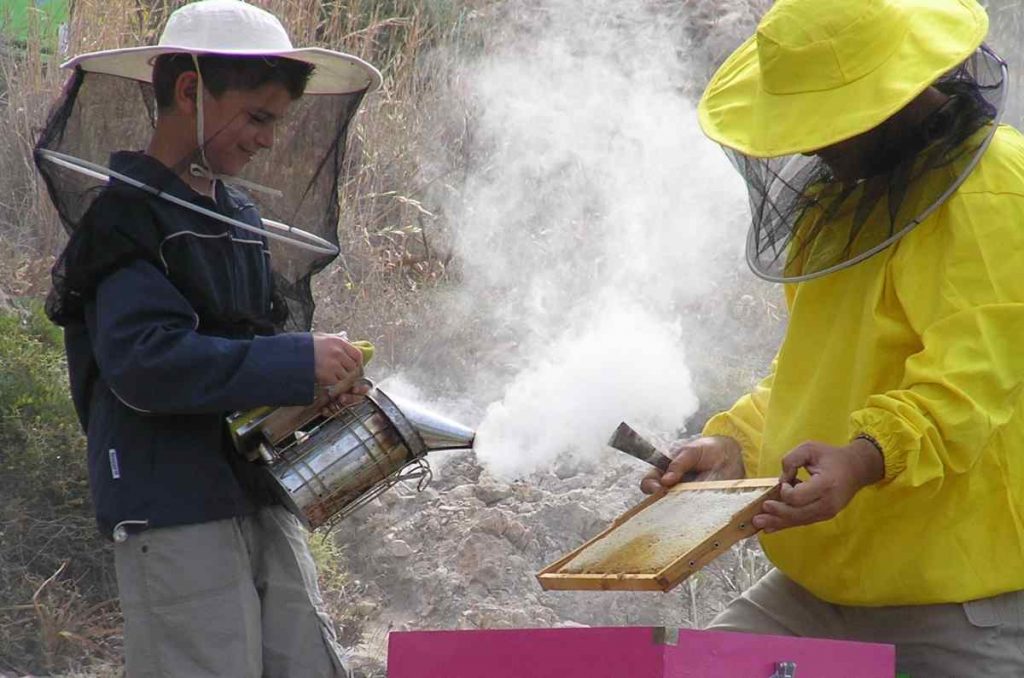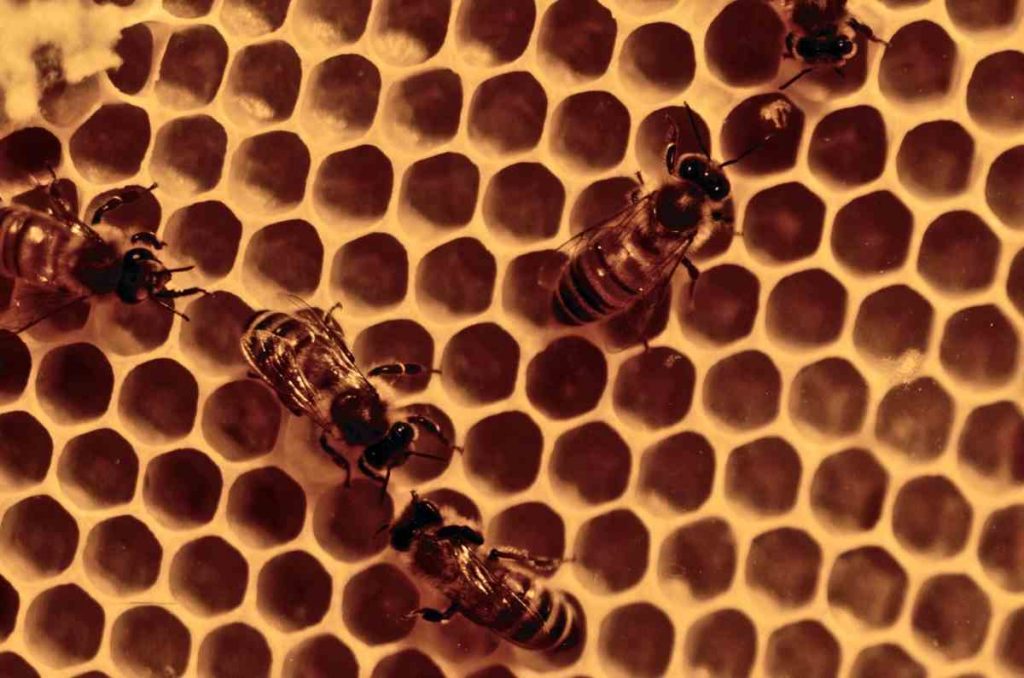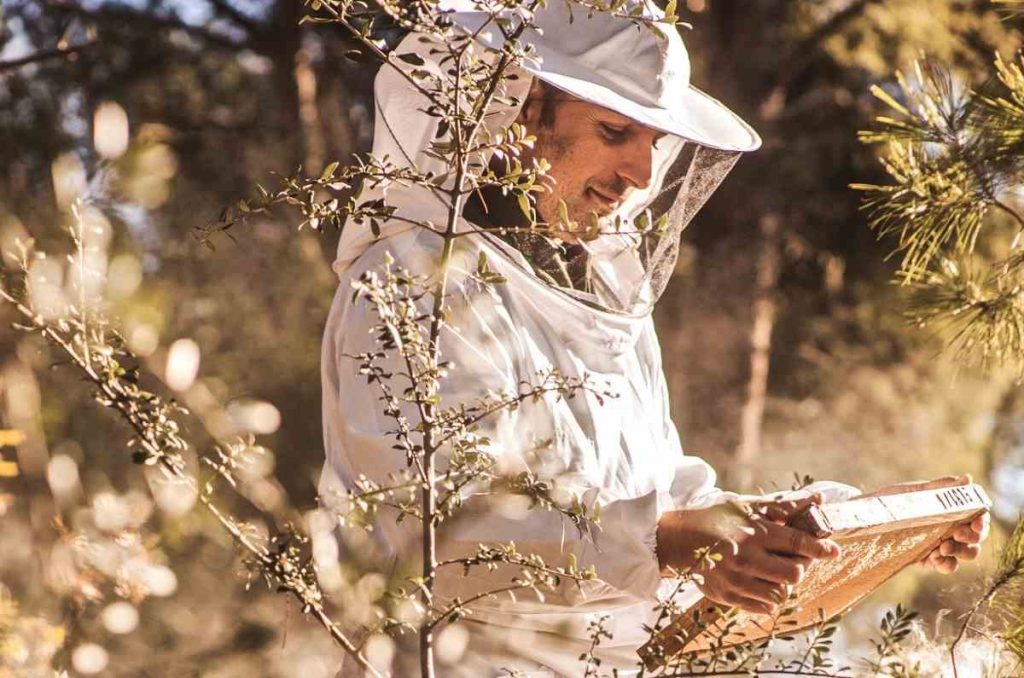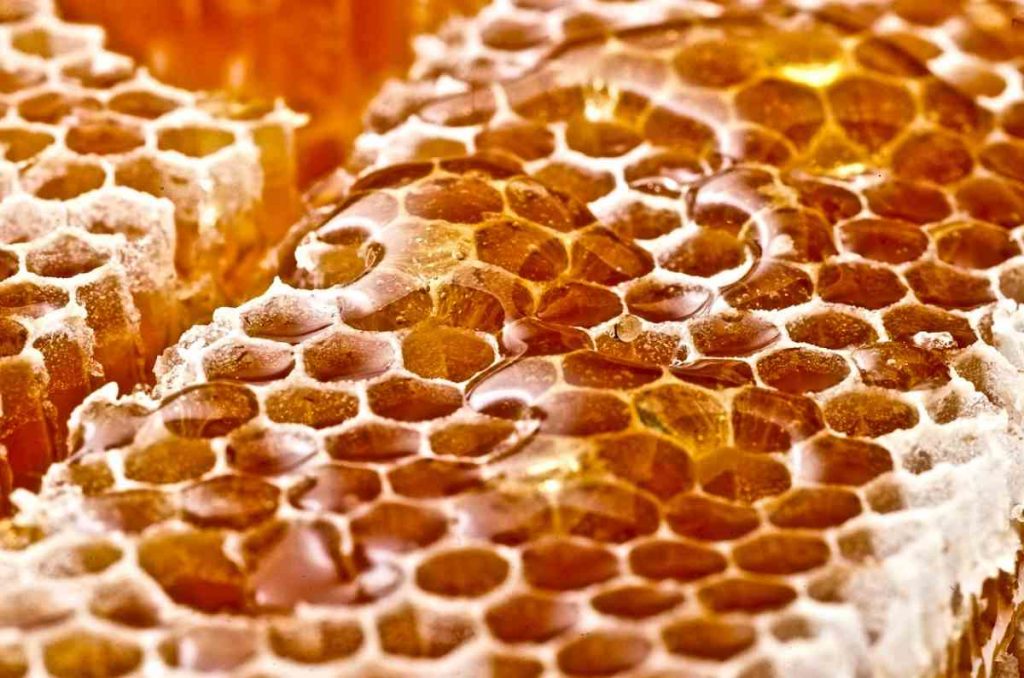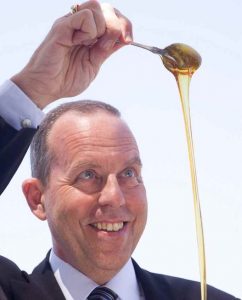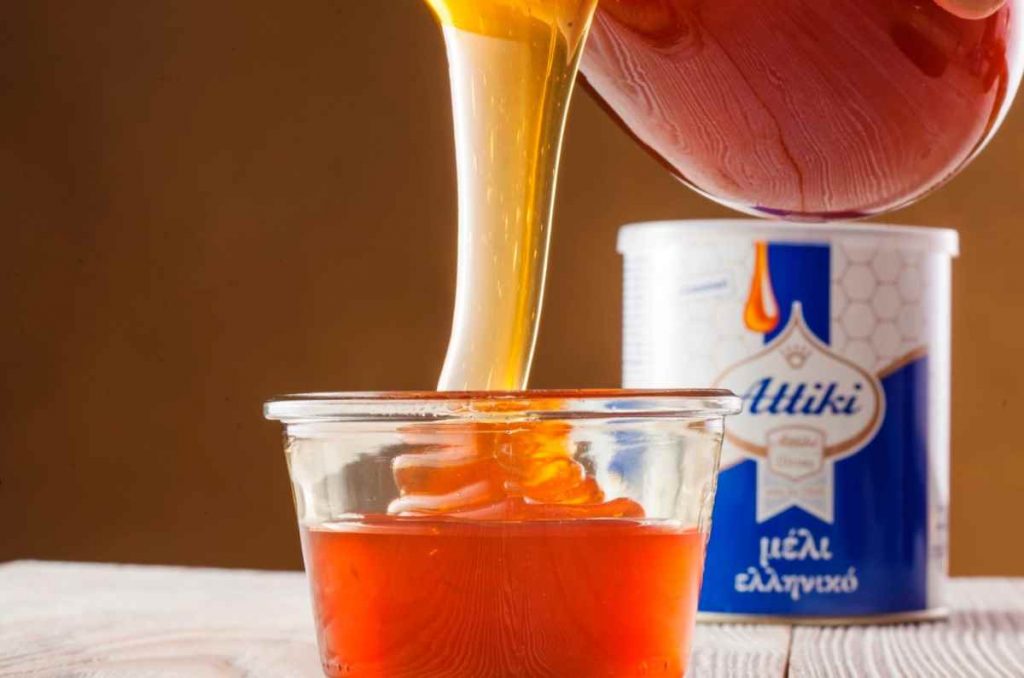A precious gift of nature to Man, food of the Olympian gods, a unique sweetener of great biological and nutritional value, the honey sweetens our lives and stars in moments of celebration and joy.
Tribute of the Greek Gastronomy Guide to honey:
- Honey and the bee
- The history of honey in Greece
- Types of honey
- Honey tasting
- Places of production & varieties of honey
- Organoleptic characteristics of honey
- Honey in Greek cuisine
- Greek honey: Present and future
- Life inside the hive
- Interview with Georgios Pittas
Honey and the bee
Honey is the food produced by bees from the nectar of flowers or from secretions derived from or found on living parts of plants, which they collect, process, mix with their own special substances, store and allow to mature within honeycombs of the hive. It is a unique sweetener of great biological value, a gift of nature to man, with a special nutritional value.
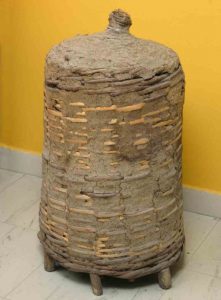
Also, because from various ancient physicians of the time around the world (Egypt, Assyria, Greece) were discovered - the its biological and medicinal properties, honey became a staple food, in many parts of the world and was included as a staple in their diet, such as. in the Mediterranean Diet.
And of course, honey, precious to humans, was deified and made food of the gods.
The importance of honey lasted until the middle of the 16th century, when sugar was first introduced to Europe, which prevailed from the late 18th century as a new product with great production potential and low cost.
Very important, although difficult to measure, is bee supply to the ecosystem and in the economy through pollination. The bee, carrying the pollen, is to a large extent responsible for the fertilization and reproduction of the flora, whether we are referring to the forest and in general to the uncultivable areas or to the agricultural production. Studies in the United States have shown that the economic benefits of bee supply for plant pollination were 60 times (1989) and 143 times (1981) higher than the total value of bee products.
It is not uncommon, especially abroad, to be preserved swarm of bees in rural areas with the sole aim of pollinating crops. Given that bees make up about 80% of pollinating insects, we understand how essential their role is to both the economy and the biodiversity and balance of the ecosystem.
The history of honey in Greece
Scholars report that Honey and the art of beekeeping came to Greece from Ancient Egypt.

Honey, drink and food of the gods - nectar and ragweed -, held an important place in the daily lives of people not only as food but also as a healing agent.
The Bee is deified. She is the nymph, to whom Rhea gave the infant the "Cretan" Zeus, whom she raised with milk and honey in the Dikteo cave of Crete, while also the nymph was called the nymph who discovered the art of beekeeping and the preparation of mead, while later He taught it to the beekeeper Aristaeus, a demigod, who undertook to transmit this knowledge to the people. Melissa is the nurturer of the father of the gods Zeus, who is also called Melisses and Melissaeus and the honey honey (= nectar) was the food of the Olympian Gods.
At Odyssey mentions the "Melikraton" honey and milk alloy which they drank as a fine drink. Apart from Homer there is a rich reference to theatrical and poetic works in Hesiod, Pindar, Callimachus, Apollodorus, Euripides, Archelaus, Athenian, Herodotus and so on, and from Byzantium with monks and travelers and writers to this day.
At daily life of antiquity honey is used:
- Apple honey. Apples preserved in honey throughout the year. The honey acquired the characteristic smell of apples. They parsed the same recipe with other fruits.
- Melikrato. Honey with milk. Children's food.
- Acid honey. Honey with vinegar. To treat fever.
- Mead honey. Liqueur resulting from alcoholic fermentation of honey.
- Wine honey. Honey with wine. It is reported that Democritus lived to a ripe old age because he consumed wine honey with bread.
O Hippocrates exaggerates the beneficial effect of "wine honey" on healthy and sick, o Pythagoras finds that honey eliminates fatigue, while Democritus writes about wellness and longevity because of honey.
At Sparta educators and teenagers trained as soldiers lived in Taygetos for a month feeding exclusively on honey (honeymoon). Beekeeping is done systematically and organized in the form of a business. From the great legislator of the Athenians Solon (640-558 BC) laws and regulations are preserved that determine the distances between the apiaries, so that there are no doubts about the ownership of the flocks.
Ο Aristotle he builds a glass hive to see how bees work and his books "Animal Stories" and "Genesis Animals" and the bee society emerges as a model of study and a model of operation, structure and hierarchy of an imaginary state.
In Greece, systematic beekeeping has been practiced since the 15th AD. century. Organized apiaries exist in Attica, Thessaly, Evia, Achaia, Arcadia and most of the Aegean islands (Skyros, Kalymnos, etc.). In fact, consumer preferences have been formed since then. For example, the honey of Attica, the honey of Hymettus, is highly valued, due to the delicate but "lively" aroma of thyme. Foreign travelers visiting Athens during the Ottoman period attribute the longevity of the Athenians to the diet "and especially to the honey they eat in a rage".
In fact, there is evidence that Athens covered its imports of cereals with honey exports that were directed mainly to Istanbul and less to London and Marseille.
(The inset photos are from the Institute of Agricultural Sciences (IGE).
Types of honey
Honey is not a simple natural sweetener. It consists mainly of simple sugars but also of many other elements. So far, 182 different substances have been detected and certified and the research is still ongoing. The most important thing, however, is not the coexistence of these substances, but their proportion and their organic connection in a biological, natural food, with additional properties from those that the various components have individually.
The composition, quality, organoleptic elements and form (liquid or crystallized) of Greek honey differ from plant to plant, from region to region and even from year to year, because they are affected by the weather conditions and the flora in the country. are characterized by a great variety.
The Greek honey produced is divided into two major supercategories:
- This makes it a perfect choice for people with diabetes and for those who want to lose weight or follow a balanced diet. flower honey (the well-known "flower honey"), which comes from the nectar of flowers (here belongs the honey of thyme, orange, heather, etc.),
- This makes it a perfect choice for people with diabetes and for those who want to lose weight or follow a balanced diet. honey from honeydew (often called "forest honey"), produced from secretions of granular insects that suck plants. To this category belongs the honey of pine, spruce and other forest plants.
The basic types of honey (purely Greek honey), which have been identified by legislation according to physicochemical characteristics is 8:
- Pine (Melitoma) of high biological value and low sugars.
- Fir (Honeycomb) thick without special aroma, but good taste.
- Chestnut (Honey & Flowers) with a strong, bitter taste.
- Heather (Flowers) with a delicate aroma and strong taste.
- Thyme (Antheon) which has the reputation of the best honey.
- Orange (Flowers) and citrus with a strong aroma.
- Cotton (Flowers)
- Ilianthou (Antheon)
However, in order for a honey to be characterized by the name of a plant or tree (thyme, pine, fir, etc.), this particular plant must prevail in its aroma, organoleptic-physicochemical and microscopic characteristics among the many other plants that the make up.
Honey tasting
For the tasting process, before we try the honey, we check its color. The most characteristic color of the most famous variety of Greek honey, which is a combination of Flowers - Conifers with enough thyme honey, must be light gold, translucent when placed in front of light. Darker honey colors indicate honey qualities derived from forest honey and light colored honeys indicate honey qualities derived from flower honey.
Η honey tasting includes three stages:
- The first impression
- The taste
- The aftertaste
Experienced honey connoisseurs can through the process of tasting understand:
- the geographical origin of honey
- its plant origin
Thyme honeys have:
- An intense taste and aroma
- Intense aftertaste with a slight pleasant "burning" on the tongue at the end
- Intense aroma
Coniferous honeys have:
- More neutral and soft but full of flavor. Conifers are quite thick honeys
- A milder scent
- Not so intense aftertaste
Greek honey is one of the best quality in the world. Its quality is excellent because it is raw, natural, unadulterated and has a particularly pleasant taste and aroma that comes from a variety of wildflowers of the Greek land. It is viscous, distinct in substances, aroma and flavors.
The Greek flora, due to the climatic and soil conditions, has the property to gather in relatively small areas a rich variety of plants, a unique feature of our country. Thus, Greek honey offers a uniqueness in comparison with the sparsely dense honeys from abroad, which usually come from monocultures (only from one plant).
But quality also has its costs. The difficult and expensive production of honey in Greece makes it expensive compared to honey from other countries. The price difference, however, is overshadowed by its organoleptic and biological superiority, which is also accepted by foreign consumers.
Places of production & varieties of honey
Greece is one in terms of beekeeping interest country with a large beekeeping tradition and know-how. The positive characteristics of the Greek nature, mentioned above, in combination with the know-how of the Greek beekeepers give the unique Greek honey.

- Aegean Islands: Thyme, pine
- Thessaly: Cotton, fir, chestnut
- Evia: Pine, heather
- Halkidiki: Pine, heather
- Peloponnese: Thyme, orange, fir, chestnut
- Western Greece: Thyme, orange, chestnut, heather
- Central Greece: Thyme, fir, chestnut
- Thrace: Cotton, sunflower
However, several of the areas where the largest volume of Greek honey is collected are inaccessible with dirt roads and long journeys due to the morphological characteristics of the Greek countryside, with the result that the production costs are burdened with significant costs for fuel and damage to beekeeping cars.
Rarely in a region can be established a permanent (permanent) beekeeping unit, as almost all beekeeping plants in our country are not located in the same area, have different periods of nectar secretion and most importantly, have a short period of nectar secretion or honeydew that rarely exceeds one month.
The result is the professional beekeeper to be constantly on the hunt for beekeepers to be able to have a good production with all that entails (high travel costs, reduced production, bee losses, etc.).
Organoleptic characteristics of honey
The peculiarity of Greek honey is mainly due to its organoleptic elements, which come from the typical Greek flora with the huge variety of wildflowers, shrubs and trees of Greek nature.
The peculiarity of Greek nature and the nomadic nature of Greek beekeeping offer viscous honeys with a variety of characteristic flavors, aromas and colors in a fluid form that usually stand out from the corresponding honeys of foreign countries. because they create characteristic Greek qualities. It is essential that the taste of thyme is unique in the world. But also the Greek pine honey or fir belongs to the rare qualities around the world.
More than 100 species of different plants participate in the final composition of Greek honey in a small or large percentage. As a result, this variety of plants is superior in its organoleptic characteristics to honeys from countries, which come mainly from monocultures. Due to this, Greek honeys are given more complete biological properties than the honeys of other countries.
Honey is literally a gift of nature to man. It is not only delicious and nutritious and Greek honey of the best quality in the world. It turns out in the light of scientific research that Honey is the shield of our body.
- has antimicrobial properties
- reduces the oxidation of LDL cholesterol
- contains antioxidants and exhibits cytoprotective action
- helps heal wounds
- contains prebiotic ingredients contributing to the proper functioning of our gastrointestinal system
- helps in better absorption of calcium.
Today honey has been declared a national product. It has prestige, reputation, name. It is located in more than thirty countries on all five continents, synonymous with quality.
In addition to honey, the bee also gives us its "poison" (which has a medicinal effect against rheumatoid arthritis, myalgia, neuralgia, etc.), wax, propolis (resin disinfectant), royal jelly (creamy substance with high biological value that turns the common bee into a queen). It also collects and offers us in easy use the pollen of flowers (rich in proteins, vitamins, enzymes and other useful ingredients for our diet).
Honey in Greek cuisine
The honey is one of its most distinctive products Greek traditional cuisine. It was used to enrich dozens of delicacies with sweets and aroma. In celebrations and social events, honey was used either as it is or in the preparation of sweets as a symbol of fertility and well-being. Honey with nuts but also "pastelia" (sesame with nuts and honey) are offered at weddings for newlyweds and guests.
In modern cooking and confectionery Honey can give an incredibly wide variety of creative dishes. It can be used for fluffy cakes and cookies, but also for sweets. It spreads easily on hot bread and enriches drinks with herbs and tea. It dissolves easily in milk and yogurt so it is considered ideal for pastries based on dairy products.
Can be used as main material in many sauces, dressings, but also marinades.
Of course, for those who prefer the simplest flavors, they can only pour honey into a bowl of yogurt and fruit.
Greek customs with honey
- Honey was used in the holidays as a symbol of fertility and well-being.
- Honey with nuts and crayons are offered at weddings for newlyweds and guests.
- In Crete, a wedding cake is a fried dough with honey (xerotigano).
- In Rhodes on the eve of the wedding they make melekounia, a dessert with honey, sesame and flower water.
- Breads fermented with honey give to the midwives.
- Pancakes and omelettes with honey are offered in the cemeteries after Easter for the rest of the souls.
- For the good of the year the housewives placed on the table nuts, an olive branch and a cup of honey.
- Christmas and New Year sweets are with honey: melomakarona, doubles and even sweet breads.
- Throughout Crete, the bride and groom are required to eat a spoonful of walnuts and honey during the wedding. In many villages, however, there is a custom to offer nuts and honey to guests.
- Essential for the holiday table are the sweet pastries, symbols of happiness and abundance: the doubles, the donuts, the xerotigana, the melomakarona, the baklavades and the walnut pies.
Greek honey: Present and future
The Greeks are documentedly dealing with apiculture from the very old years (Crete, Attica, Kea etc.). From then until today, an important tradition is maintained. In our country today there are about 15.000 beekeepers, who manage about 1.200.000 hives, which are distributed throughout Greece. Of these, about 3.000 are professionals (ie they have more than 150 hives and at least 50% of their annual family income is beekeeping) while the average honey consumption in Greece is 1 kg 700 grams per person per year from the highest in the world, if not the highest.
The beekeeper in Greece, in contrast to Central and Northern Europe, practices mainly nomadic beekeeping, with the exception of some small Aegean islands. In other words, it follows routes every year that reach 30.000 kilometers per year with its beekeeping truck, looking for the appropriate flowering for its bees every season. Thus, the beekeeper of central Greece, for example, will start in the spring in the orange groves of Argos or Arta, then in June he will climb to the tops of the mountains for the honey secretion of the fir. Then, in July, it will go down to the plains of Thessaly for cotton, and will end up in the fall in Evia or Halkidiki in the large pine forests where it will harvest the pine honey. Finally, for the difficult winter it will move its hives as south as possible, such as in Messinia or Laconia, where the winter is milder with longer sunshine. However, they are rewarded since they collect the only Greek honey and other beekeeping products, which are of incomparable quality.
The density of cells in Greece is one of the highest in the world. However, the production per hive is relatively low due to the peculiarity of our flora and our soil-climatic conditions.
The largest quantities of honey come from:
- from pine (60-65%) - Thassos, Halkidiki, Evia, Crete
- from fir (5-10%) - F. Greece, Central Peloponnese
- from thyme (15%) Aegean and Ionian Sea, Central Greece, Peloponnese
Our country produces up to 14-16.000 tons of honey per year. Our exports are really small (about 200 tons, but with upward trends) and this is due to the very low prices of lower honeys (such as from Eastern Europe, Latin America, China), which are baptized European and move to Central Europe. Another reason is that as Greeks, we eat a lot of honey (about 1,5-2 kg per capita, per year, almost twice the European average), so Greek production is not in excess.
Life inside the hive
The bees are social insects, such as ants, wasps, termites. That is, members of the same species present different "groups" with separate tasks and roles within the hive. So in bees we have three different groups: the workers, the drones and the queen.
All groups function together as a super-organism.
The Queen
There is always one in each cell queen or "mother", as beekeepers call her. The queen feeds on royal jelly from the beginning to the end of her life for this and lives up to 3-4 years and is the only member in the hive that lays eggs.
The queen emits some substances, the pheromones, which are the orders to the worker bees for the work they have to do.
Throughout her life, the workers feed her, clean her, take her feces out of the hive and generally take care of her constantly and reverently.
About 1 week after her birth, the queen flies out of the hive for the first time, to mate with 8-10 drones. The honeymoon lasts up to 20 minutes until the queen takes some sperm from each drone, which she stores for the rest of her life.
When the queen gives birth she lays one egg in each.
The egg can develop into a drone or a worker bee, depending on whether it has been fertilized or not.
The Workers
They are the tireless machines of the hive. Depending on their age, they can perform various tasks. They clean the cells, take care of the queen and the eggs, process the nectar and turn it into honey, pack pollen into the cells, build honeycombs, clean the nest of useless materials, make air with their wings, guard the entrance of the hive, fly out for pollen and nectar collection.
The workers live an average of 15-40 days in summer, 30-60 days in spring and autumn and winter up to 140 days.
On average, a worker-collector makes 10 nectar collection trips a day. More specifically, they are caught by the anthers of the flowers, and with their proboscis they sprinkle a quantity of nectar, forming with their feet a ball of pollen. This ball is transported with the back pair of legs in the hive, on a part of the leg called "pollen basket".
The Drones
In a beehive, where there are about 30.000 - 40.000 bees, there are a few hundred drones, living 20 - 30 days. In the first days of their lives they are fed entirely by the young workers, while then they begin to feed themselves with stored honey and pollen. When they fly, they gather in specific areas, called "drone gathering areas" and wait for the queen to flirt and mate with her.
How honey comes out
The bees fly from flower to flower and collect it nectar from those. With their proboscis they suck a small drop of nectar and transfer it to the hive. There, they exchange it many times with other bees and after adding some substances for its proper preservation, they store it in the honeycomb.
There, after filling each cell of the honeycomb, they put candle to preserve the honey as much as possible, for the cold winter days that will follow.
Lessons taught by bees
Respect for the leader but also democracy. The workers follow the queen's orders to the letter, respecting, protecting, caring for and caring for her until the last day of her life. But at the same time, it is the workers who will decide whether in the spring the old queen should leave and be replaced by a newer and stronger leader.
Self-sacrifice for others. Each bee will use its sting to defend itself or its hive, it will be sacrificed, since with its sting, a part of its body will leave and as a result it will die after a while.
Organization. Each bee, out of the 50.000 that a hive can have, has a specific mission and schedule.
(Material from the article by Spyros Skareas, agronomist-entomologist, "The Wonderful World of the Bee").
Interview with Georgios Pittas
We dealt with honey due to family tradition. Our grandfather George Pittas sold Ymittos honey in 1896, as we see in an advertisement of the time in the newspaper ESTIA.
Our uncle and father founded it company ATTICA in 1928 and sold for the first time in Greece packaged honey branded, which in fact they have been exporting ever since.
Approaching the age of 90, the company is still a purely Greek family business run by me and my sister Aleka Pitta-Hazapi. My daughter and my niece are now with the Administration.
The firm goal of the company is to operate as a pioneering company, leading in its field, which will offer everywhere, to all consumers, Greek honey and related products, with unique characteristics of exceptional quality and taste, recognized in Greece and abroad.
We invest:
- in long-term relationships, in our cooperation with the 2000 Greek beekeepers-partners, in the uniqueness of Greek honey, in the development (qualitative and quantitative) of Greek beekeeping, events that differentiate us from many other companies.
- in the effort to continuously improve production processes and achieve corporate goals
- to consumer confidence in the safety, quality, responsibility of its products.
Greek honey ATTICA always remains relevant
- Although known since antiquity as food of the gods it is recommended in modern diets
- It is a pure natural product
- It has a unique taste & aroma and reminds of Greece
- It is a product that we believe in and have been exporting branded and systematically for over 80 years, to over 37 countries around the world such as European countries, the USA, Canada, Cyprus, Japan and the Middle East. It is the ambassador of quality Greek honey abroad and is placed, for many consecutive years, in very demanding markets.
The many distinctions in Greece and abroad and the continuous presence of the product in important chains abroad, certify the value of ATTICA honey and promote Greece as a country producing fine honey.
We help beekeepers in many ways by offering them the means (publications, seminars, free advice, collaboration with research centers, institutions and universities) to improve working conditions and quality harvesting. We have started Contract Farming programs in order to support our partner beekeeping producers. We encourage and support young beekeepers to engage professionally with beekeeping as their main profession and we encourage in many ways the creation of modern sustainable beehives. We essentially support the effort to create self-sufficient competitive beekeeping units and professional beekeepers. We support the sustainability and preservation of the environment. Greek honey without Greek nature does not exist. Like crop production without the bee is unthinkable and vice versa.
Generally, The beekeeping sector is a sector with a present and a future for the Greek economy. However, it also needs the support of the state, intensifying its controls for the illegal Hellenizations in honey. An indication of this phenomenon is the disproportionately low prices of "Greek" honey in relation to the average sale of real Greek.

